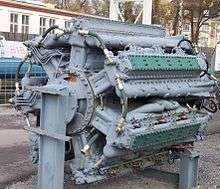Cylinder bank


Internal combustion piston engines (those with more than one cylinder) are usually arranged so that the cylinders are in lines parallel to the crankshaft. Where they are in a single line, this is referred to as an inline or straight engine.
Where engines have a large number of cylinders, the cylinders are commonly arranged in two lines, placed at an angle to each other as a vee engine. Each line is referred to as a cylinder bank. The angle between cylinder banks is described as the bank angle.
Number of cylinders
Engines with six cylinders are equally common as either straight or vee engines. With more cylinders than this, the vee configuration is more common. Fewer cylinders are more usually arranged as an inline engine. There are exceptions to this: straight-8 engines were found on some pre-war luxury cars with the bonnet length to house them. A few V4 engines have also been produced, usually where an extra-compact engine was required, including some outboard motors with a vertical crankshaft. Although twin-cylinder engines are now rare for cars, they are still commonly used for motorcycles and the vee-twin and inline twin are both widely used.
Advantages of multi-bank engines
An obvious advantage to a multi-bank engine is that it can be shorter in length. This allows a torsionally stiffer construction for both the crankshaft and crankcase. The most important advantage though is less obvious: a multi-plane engine can be arranged to have better balance and less vibration. This depends on the layout of the crankshaft more than the cylinder banks alone: the planes on which the pistons are arranged, thus their timing and vibration, depend on both the cylinder bank and the crankshaft angles.
Unusual arrangements
The W or broad arrow arrangement uses three cylinder banks, usually a W-12 with three banks of four cylinders.
Narrow-angle vee engines, such as the Lancia V4 and the Volkswagen VR6, have such a narrow bank angle that their cylinders are combined into a single cylinder block. These are still described as vee engines, although they may be described as having either two (as for other engines) or (more commonly in these cases) one cylinder bank.
Radial engines
In a radial engine, cylinders are arranged radially in a circle. Simple radials use one row (i.e. one circle) of cylinders. Larger radials use two rows, or even four. Most radials are air-cooled with separate cylinders and so there are no banks as such. Most radials also have odd numbers of cylinders in each row and stagger these between successive rows, for better cooling.
A few rare radial engines, such as the Armstrong Siddeley Deerhound[1] and the Zvezda M503 (illustrated) have arranged their multiple rows so as to align their cylinders into banks.
References
- ↑ Gunston, Bill. World Encyclopedia of Aero Engines. Cambridge, England. Patrick Stephens Limited, 1989. ISBN 1-85260-163-9